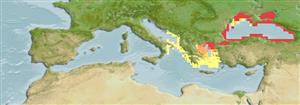>
Gobiiformes (Gobies) >
Gobiidae (Gobies) > Gobiinae
Etymology: Proterorhinus: Greek, proteros = former + Greek, rhinos = nose (Ref. 45335).
More on author: Pallas.
Issue
Name should be changed to Proterorhinus semilunaris Heckel 1837 according to: Stepien C.A. & M.A. Tumeo, 2006: Invasion Genetics of Ponto-Caspian Gobies in the Great Lakes: A ‘Cryptic’ Species, Absence of Founder Effects, and Comparative Risk Analy
Environment: milieu / climate zone / depth range / distribution range
Ecologia
marino; acqua dolce; salmastro demersale; pH range: 7.0 - 7.5; dH range: 10 - ?; amfidromo (Ref. 46888). Temperate; 4°C - 18°C (Ref. 2060); 60°N - 36°N, 17°E - 54°E
Eurasia: rivers and estuaries of Black Sea, Sea of Azov and Caspian Sea, including tributaries. In the Mediterranean, occurs only in the Evros and Strymon systems, which empty in the northern Aegean Sea.
Size / Peso / Age
Maturity: Lm ? range ? - ? cm
Max length : 11.5 cm TL maschio/sesso non determinato; (Ref. 2058)
Short description
Chiavi di identificazione | Morfologia | Morfometria
Spine dorsali (totale) : 7 - 8; Raggi dorsali molli (totale) : 14 - 18; Spine anali: 1; Raggi anali molli: 12 - 15. Seven transverse suborbital rows, complete oculoscapular and preopercular lateral-line canals, scaled nape and as a distinctive autapomorphy, an elongate anterior nostril, which extends over the upper lip. Broad dark oblique banding across the body.
Pure inhabitant of brackish waters (Ref. 92840). Occur in rivers and estuaries (Ref. 4696). Based on morphological and molecular data, this species does not enter pure freshwater and inhabits brackish waters in Sevastopol, Crimea (Ref. 59043).
Life cycle and mating behavior
Maturities | Riproduzione | Spawnings | Egg(s) | Fecundities | Larve
Miller, P.J., 1990. The endurance of endemism: the Mediterranean freshwater gobies and their prospects for survival. J. Fish Biol. 37(Suppl.A):145-156. (Ref. 12215)
IUCN Red List Status (Ref. 130435)
Threat to humans
Harmless
Human uses
Pesca: commerciale; Acquario: Commerciale
Strumenti
Special reports
Download XML
Fonti Internet
Estimates based on models
Preferred temperature (Ref.
123201): 11 - 18.3, mean 13.9 °C (based on 80 cells).
Phylogenetic diversity index (Ref.
82804): PD
50 = 0.5312 [Uniqueness, from 0.5 = low to 2.0 = high].
Bayesian length-weight: a=0.01000 (0.00606 - 0.01650), b=3.08 (2.94 - 3.22), in cm total length, based on LWR estimates for this species & (Sub)family-body (Ref.
93245).
Trophic level (Ref.
69278): 3.5 ±0.5 se; based on diet studies.
Resilienza (Ref.
120179): Alto, tempo minimo di raddoppiamento della popolazione meno di 15 mesi (Assuming tm<=1).
Fishing Vulnerability (Ref.
59153): Low vulnerability (10 of 100).
